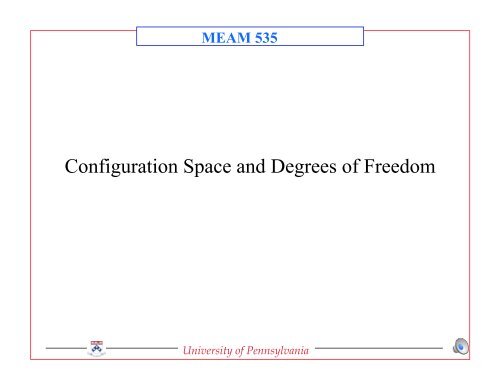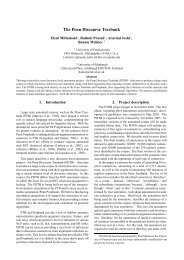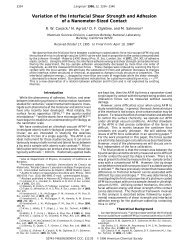Configuration Space and Degrees of Freedom - University of ...
Configuration Space and Degrees of Freedom - University of ...
Configuration Space and Degrees of Freedom - University of ...
You also want an ePaper? Increase the reach of your titles
YUMPU automatically turns print PDFs into web optimized ePapers that Google loves.
MEAM 535<br />
<strong>Configuration</strong> <strong>Space</strong> <strong>and</strong> <strong>Degrees</strong> <strong>of</strong> <strong>Freedom</strong><br />
<strong>University</strong> <strong>of</strong> Pennsylvania<br />
1
MEAM 535<br />
<strong>Degrees</strong> <strong>of</strong> freedom <strong>and</strong> constraints<br />
Consider a system S with N particles, P r (r=1,...,N), <strong>and</strong> their<br />
positions vector x r in some reference frame A. The 3N components<br />
specify the configuration <strong>of</strong> the system, S.<br />
The configuration space is defined as:<br />
ℵ= { X X ∈ R 3N , X = [ x 1<br />
.a 1<br />
, x 1<br />
.a 2<br />
, x 1<br />
.a 3<br />
,…x N<br />
.a 1<br />
, x N<br />
.a 2<br />
, x N<br />
.a 3 ] T<br />
}<br />
The 3N scalar numbers are called configuration space variables or<br />
€<br />
coordinates for the system.<br />
The trajectories <strong>of</strong> the system in the configuration space are always<br />
continuous.<br />
<strong>University</strong> <strong>of</strong> Pennsylvania<br />
2
MEAM 535<br />
What are Constraints<br />
Claim (Rosenberg)<br />
In a system <strong>of</strong> two or more particles, unconstrained motion is<br />
simply not possible.<br />
Definition<br />
If the motion <strong>of</strong> the system is affected by one or more constraints<br />
on the positions <strong>of</strong> the particles, the constraints are called<br />
configuration constraints.<br />
<strong>University</strong> <strong>of</strong> Pennsylvania<br />
3
MEAM 535<br />
A System <strong>of</strong> Two Particles on a Line<br />
<strong>University</strong> <strong>of</strong> Pennsylvania<br />
4
MEAM 535<br />
Examples <strong>of</strong> <strong>Configuration</strong> Constraints<br />
1. A particle moving on a plane in three dimensional space. The configuration<br />
space is R 3 . However, the particle is constrained to lie on a plane:<br />
A x 1<br />
+ B x 2<br />
+ C x 3<br />
+ D = 0<br />
2. A particle suspended from a string in three dimensional space. The<br />
configuration space is R 3 . The particle is constrained to move so that its<br />
distance from a fixed point is always the same. This is called a spherical<br />
pendulum.<br />
(x 1<br />
– a) 2 + (x 2<br />
– b) 2 + (x 3<br />
– c) 2 – r 2 = 0<br />
3. Two particles attached by a massless rod. The configuration space is R 6 . The<br />
two particles are constrained so that the distance between them is a constant.<br />
(x 1<br />
– x 4<br />
) 2 + (x 2<br />
– x 5<br />
) 2 + (x 3<br />
– x 6<br />
) 2 – r 2 = 0<br />
4. A particle constrained by the equation below is constrained to move on a<br />
circle in three-dimensional space whose radius changes with time t.<br />
x 1<br />
dx 1<br />
+ x 2<br />
dx 2<br />
+ x 3<br />
dx 3<br />
- c 2 dt = 0<br />
<strong>University</strong> <strong>of</strong> Pennsylvania<br />
5
MEAM 535<br />
Examples <strong>of</strong> Constraints<br />
Example 1<br />
Are these configuration constraints<br />
z<br />
Example 2: Disk rolling on plane<br />
Rolling constraint at P a<br />
q 2<br />
3<br />
A particle moving in a horizontal plane (call it the x-y plane) is steered in<br />
such a way that the slope <strong>of</strong> the trajectory is proportional to the time elapsed<br />
from t=0.<br />
x<br />
a 2<br />
b 2<br />
y<br />
a 1<br />
e<br />
b 2 C<br />
3<br />
C*<br />
q 4<br />
q 1<br />
q 3 b 1<br />
P<br />
q 5<br />
e 3<br />
e 1<br />
<strong>University</strong> <strong>of</strong> Pennsylvania<br />
6
MEAM 535<br />
<strong>Degrees</strong> <strong>of</strong> <strong>Freedom</strong><br />
Consider a system <strong>of</strong> N particles, S, in a reference frame A.<br />
A 3N-dimensional configuration space is associated with the system S.<br />
When there are one or more configuration constraints not all <strong>of</strong> the 3N<br />
variables describing the system configuration are independent.<br />
The minimum number <strong>of</strong> variables (also called coordinates)<br />
required to completely specify the configuration (position <strong>of</strong><br />
every particle) <strong>of</strong> a system is called the number <strong>of</strong> degrees <strong>of</strong><br />
freedom for that system.<br />
1. No. <strong>of</strong> degrees <strong>of</strong> freedom = No. <strong>of</strong> variables required to describe the system<br />
- No. <strong>of</strong> independent configuration constraints<br />
2. No. <strong>of</strong> degrees <strong>of</strong> freedom <strong>of</strong> a system depends on reference frame.<br />
Controversial!<br />
<strong>University</strong> <strong>of</strong> Pennsylvania<br />
7
MEAM 535<br />
Definitions<br />
<strong>Degrees</strong> <strong>of</strong> freedom <strong>of</strong> a system<br />
The number <strong>of</strong> independent variables (or coordinates) required to completely<br />
specify the configuration <strong>of</strong> the system.<br />
Point on a plane (2-D)<br />
Point in 3-D space<br />
Line on a plane<br />
Kinematic chain<br />
A system <strong>of</strong> rigid bodies connected together by joints. A chain is called<br />
closed if it forms a closed loop. A chain that is not closed is called an open<br />
chain.<br />
<strong>University</strong> <strong>of</strong> Pennsylvania<br />
8
MEAM 535<br />
<strong>Degrees</strong> <strong>of</strong> <strong>Freedom</strong>: Example<br />
Q<br />
Q<br />
Q<br />
P<br />
P<br />
P<br />
A<br />
A<br />
A<br />
No. <strong>of</strong> degrees <strong>of</strong> freedom<br />
= No. <strong>of</strong> variables required to describe the system<br />
- No. <strong>of</strong> independent configuration constraints<br />
<strong>University</strong> <strong>of</strong> Pennsylvania<br />
9
MEAM 535<br />
The Planar 3-R manipulator<br />
Planar kinematic chain<br />
All joints are revolute with connectivity = 1<br />
What is the number <strong>of</strong> degrees <strong>of</strong> freedom<br />
Link 3<br />
Link 2<br />
Joint 3<br />
Link 1<br />
Joint 2<br />
Joint 1<br />
<strong>University</strong> <strong>of</strong> Pennsylvania<br />
10
MEAM 535<br />
Open Kinematic Chains<br />
The Adept 1850 Palletizer<br />
Planar manipulator<br />
No. <strong>of</strong> degrees <strong>of</strong> freedom (d<strong>of</strong>) = no. <strong>of</strong> independent 1 d<strong>of</strong> joints.<br />
<strong>University</strong> <strong>of</strong> Pennsylvania<br />
11
MEAM 535<br />
Connectivity, Mobility, <strong>and</strong> <strong>Degrees</strong> <strong>of</strong> <strong>Freedom</strong><br />
Mobility or number <strong>of</strong> degrees <strong>of</strong> freedom <strong>of</strong> a (general) planar<br />
kinematic chain<br />
General expression<br />
n number <strong>of</strong> links<br />
( ) + f i<br />
M = d n − j −1<br />
j<br />
∑<br />
i=1<br />
€<br />
j number <strong>of</strong> joints between the links<br />
f i connectivity <strong>of</strong> joint i (1 for revolute <strong>and</strong> prismatic, 3 for spherical)<br />
<strong>University</strong> <strong>of</strong> Pennsylvania<br />
12
MEAM 535<br />
Examples: Mobility (<strong>Degrees</strong> <strong>of</strong> <strong>Freedom</strong>)<br />
Ingersoll R<strong>and</strong> machine tool (Stewart Platform)<br />
number <strong>of</strong> links, n = 20<br />
number <strong>of</strong> joints, j = 24<br />
connectivity, f i = 1 or 3<br />
LEG 3<br />
END EFFECTOR<br />
LEG 4<br />
END EFFECTOR<br />
S<br />
Leg 5<br />
Leg 4 LEG 2 Leg 6<br />
LEG 5<br />
P<br />
LEG 1<br />
Leg 3<br />
Leg 2<br />
Leg 1<br />
LEG 6<br />
R<br />
R<br />
( ) + f i<br />
M = 6 n − j −1<br />
g<br />
∑<br />
i=1<br />
BASE<br />
M =<br />
BASE<br />
( 19 − 24) + 36 6<br />
6 =<br />
LEG NO. i<br />
€<br />
<strong>University</strong> <strong>of</strong> Pennsylvania<br />
13
MEAM 535<br />
Rigidly Connected System <strong>of</strong> Particles in 3-D<br />
No. <strong>of</strong> degrees <strong>of</strong> freedom<br />
= No. <strong>of</strong> variables required to describe the system<br />
- No. <strong>of</strong> independent configuration constraints<br />
Number <strong>of</strong> particles<br />
rigidly connected, N<br />
3N- N C 2<br />
Number <strong>of</strong><br />
degrees <strong>of</strong><br />
freedom, n<br />
2 5 5<br />
3 6 6<br />
4 6 6<br />
5 5 6<br />
6 3 6<br />
<strong>University</strong> <strong>of</strong> Pennsylvania<br />
14







